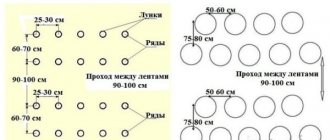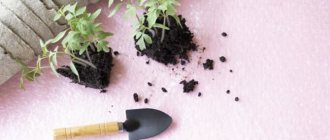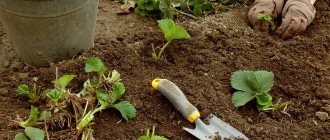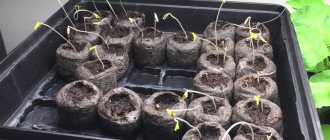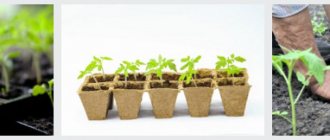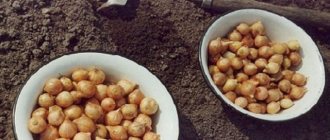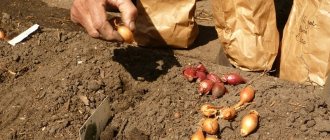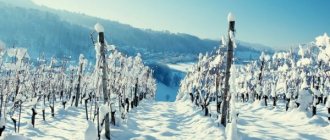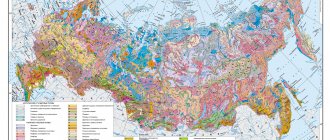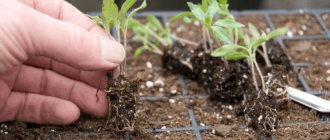The benefits of autumn planting
Planting onions in autumn before winter has the following significant advantages:
- cost savings;
- early harvest;
- pest resistance;
- good preservation of vegetables.
In the fall, you can buy small sets inexpensively - gardeners try to get rid of them, since they do not last until spring. Planting a large number of such onions in the Moscow region before winter guarantees that some of them will definitely sprout, despite poor climatic conditions. Small sets do not form shoots and will give a good harvest of turnips. You can also use a small number of large specimens per pen.
An important advantage of winter planting in the Moscow region is the early harvest. In July, the plant is already ripening - the onion fly will not cause serious harm to it. Weeding also becomes easier. The product from autumn planting is stored better and longer, as it is initially strong and healthy.
Preparing the bed
Regardless of the chosen variety, you need to plant onions before winter in pre-dug and prepared soil. After digging, the soil should have time to settle and compact a little, only then can you begin to plant. The height of the bed should be about 18-20 cm. A low bed will not save you from frost in winter.
Let's get started:
- For seeding up to 1 cm in size, make furrows 4 cm deep (for light soil) or 2 cm (for heavy soil). We bury the smallest seeds no more than 2 cm. The distance between the furrows should be maintained within 15-20 cm.
- We lower the set into the grooves so that the neck is 1.5-2 cm below ground level. The distance between plants in a row is 8-10 cm. Before planting, the onions are not soaked and the neck is not cut, as during spring planting.
- Cover the top with earth, then you can mulch with humus. This will reduce evaporation and protect the roots from freezing.
- At the next stage, it is recommended to additionally insulate the onions for the winter with sawdust, dry leaves, and spruce branches, which will need to be removed in the spring as the snow melts. During the cleaning process, be careful not to touch the young shoots - they may not be visible under the layer of insulation.
After you have finished planting, there is no need to water the onions. If the weather is dry, you can moisten the soil a little after ten days. After the onset of frost, you can additionally cover the onion with dry branches, which will hold the insulation in place and hold back the snow during the winter months. If the winter is snowy enough, the snow itself will serve as additional shelter. In snowless, cold winters, it is worth additionally covering the top with plastic film.
Planting onions on greens is no different from the process described. The only difference is in the selected variety and the size of the set.
After winter, the onion beds need to be opened. This is done when the soil has already warmed up. The film retains moisture, the seeds can get wet or rot, and the mulch will not allow the sprouts to develop freely. The film must be removed earlier, and the mulch must be removed about a week after that. When the ground is cleared, it is once again sprinkled with ash and thoroughly loosened.
Helpful tips for planting onions in winter:
- Landing time is individual for each region, but on average it is mid to late October (if the ground is not frozen yet).
- It is better to cover the planted onions (mulch) with peat or sawdust with a layer of 2-3 cm to protect the sets from freezing. You can do this a little later, but definitely before frost sets in.
- In winter, you can additionally insulate it with a layer of snow; at temperatures below - 10°C, such protection will not hurt.
- For the same purpose, you can throw grass, leaves, small twigs on top - they will hold the snow well.
- In the spring, remove the cover and make sure that there are no puddles on the surface of the bed; the seedlings may get wet and rot.
Onions planted in winter ripen earlier than spring plantings and usually produce a large, strong onion, regardless of the variety chosen. Insects (onion fly) do not have time to spoil the plants, since by the time they are active, the set has acquired a good root system that is inaccessible to the laying of fly eggs.
Winter onions are profitable and convenient, but it is not always possible to grow a good harvest. This may be the result of a gardener’s mistake (planting too deep or too early, lack or lack of insulation, incorrectly chosen variety) or the vagaries of the weather. In some regions, frosts in winter are so severe that no insulation will help. In practice, you can only understand which varieties will give a good harvest in your garden through trial and error. Try to choose local varieties adapted to weather conditions and follow all the rules for planting and caring for onion beds.
If you prefer to plant onions before winter, then it is important to decide on the variety and choose the right planting material. A sufficient number of special winter varieties of onion sets have now been developed. Small-fraction onions are well suited for winter sowing. Early and medium varieties with a ripening period of 2-3 months are preferred. I have selected the best varieties that are recommended to be planted before winter. They are universal in purpose and suitable for most growing regions.
Timing for planting onions before winter in the Moscow region
Sowing onions before winter in the Moscow region is carried out at a certain time. In order for the plant to take root, it must be planted 25–35 days before the onset of persistent cold weather. Early unexpected frosts can destroy the root system of the bulbs, so there is no need to skimp on planting material in the fall. The optimal time for the procedure in the Moscow region will be the first and second ten days of October.
Important! The set requires a large amount of moisture, it needs to get stronger and take root well. But it should not begin to grow and sprout - in this case its frost resistance will noticeably decrease.
What types of onions can be planted before winter?
Almost all types of onions are suitable for winter planting, except leeks. Typically planted:
- Nigella is a seed material from which small onion sets for planting and onion greens are obtained in the spring.
- Oatmeal (sevok) is a planting material that produces a full-fledged head in July.
- Batun is a perennial variety that provides early spring green vitamins.
- Shallots are a frost-resistant species that produces up to 15 heads from one bulb.
Onion varieties for winter in the Moscow region
Not every variety is suitable for autumn planting. Such species are specially bred by breeders. Spring varieties are not suitable for autumn planting before winter in the Moscow region, since in the spring all the onions will shoot and the harvest will be destroyed.
Black onion
Nigella is the name given to onion seeds produced in inflorescences. They are quite small and have a dark gray or black color. In the Moscow region, such seeds can be planted before winter, but they will germinate only in early spring.
Nigella is best used in late October or early November. Seeds can be planted in frozen ground and even under snow. You need to dig grooves in the soil up to 3 cm deep and at a distance of 15–20 cm from each other. In the Moscow region, it is better to sow seeds more densely, since not all of them will sprout. After planting before winter, the furrows should be covered with 2 cm of soil, the soil should be watered and mulched with peat or sawdust.
Onion on turnip
The time for planting onions on turnips before winter in the Moscow region practically does not depend on the variety. The root crop requires 3-4 weeks to take root - this is exactly how long it should take before the first frost. It is not worth planting it earlier, as it may sprout and there will be no expected harvest.
Important! Experienced gardeners determine the planting date before winter based on the air temperature in the Moscow region. If it stays at + 5 0C for several days, then onions can be planted.
Onion
Onion or Chinese variety is grown throughout Russia, with the exception of the regions of the Far North. This species is planted in the ground in October-November at a stable temperature of +4–60 C.
Vegetables are comfortable where tomatoes, legumes or cabbage used to be. The best varieties for planting in the Moscow region will be the following:
- May;
- Russian winter;
- April.
Shallot
Shallot or Ashkelon variety is distinguished by its oblong, medium-sized bulbs, good early ripening and long shelf life. Planting such onions in the fall before winter in the Moscow region can be of two types:
- on greens;
- to obtain bulbs.
The process begins in late October or early November. Before the procedure, the top part of the bulbs should be trimmed to increase the yield of green shoots. There should be at least 3 cm from the top of the planting material to the soil level. The beds are covered with earth and mulched with a layer of humus up to 20 cm - so that low temperatures do not destroy the upper part of the onion.
Other varieties of onions
There are varieties that are not widely used among Russian gardeners. These are the following varieties:
- chives;
- slime;
- multi-tiered bow.
They are easy to care for and withstand winter well. The unpopularity of such species may be explained by the fact that many simply do not know about them.
Why plant onions in winter
It’s strange, but 10-15 years ago it was not customary to plant onions in winter. Even now, not everyone knows about this possibility. Meanwhile, this is a great way to get an early bow and feather. For winter planting, it is better to choose the smallest onion, up to 1 cm in diameter. These bulbs make excellent onions. And if you want to get an early onion for a feather, then opt for onions measuring 1.5-3 cm. They will not produce a strong onion, but a feather will appear quite quickly.
You can grow onion sets yourself, then you will definitely be sure of the quality of the chosen variety. But it does not tolerate storage very well. The smallest seeds that will produce good strong fruit dry out first during storage. It is necessary to create special conditions for storing seed, monitor its condition, and regularly sort through it.
To grow sets you will need black onion. This is not a special variety; this is the name given to the small onion seeds from which the onion sets are grown. To obtain good material (nigella), it is better to select the largest and healthiest bulbs from the selected variety. They can be planted both in spring and before winter. In summer, flower stalks (arrows) will appear on the plants among the greenery, on which umbrellas with small dark grains are formed. This is nigella.
Onions from nigella seeds take quite a long time to germinate. A good head may not have time to form in one season, but for growing seedlings this is the best option. Small onions planted in winter will produce large, strong onions.
To get truly good material, you have to try hard. In this way, it is better to grow seeds of some special variety, for example, with an unusual sweet taste or good ability to withstand winter.
It is much easier to buy a half-liter jar of sevka at the local market (for some reason it is always sold in such jars), and then sort through and sort by size. There is only one drawback - as a rule, there is no question of any variety in this case. The set may contain large and small seeds, red and yellow, round and long. If the variety is not important, then such a purchase is quite profitable - all the bulbs are clearly grown in your area, have managed to get used to the climate and will not be afraid of frost.
Winter onions produce a harvest at a time when other crops in the garden have not yet ripened. This will relieve a little of the busy schedule of spring-summer work. And in place of the former onion beds, you can place other vegetables or herbs. Thus, it will be possible to harvest from one plot twice per season.
Another undoubted advantage of planting before winter is significant time savings during the hot spring period. Yes, you will have to look after the plants, but the loss of time will be incomparable.
Planting onions before winter in the Moscow region
Planting onions before winter in the Moscow region in 2021 can begin in the third ten days of September and be completed by October 24. It is quite difficult to determine the timing, since there are temperature changes in the autumn-winter period. Before the procedure, you need to decide on the choice of location, prepare the soil and planting material.
Preparing and processing bulbs before planting
Important! You cannot treat seedlings with several different substances in a row. It is enough to use one method.
Special procedures with planting material are necessary for the following purposes:
- reducing the possibility of arrows appearing;
- disease prevention;
- stimulation of good rooting.
The workpieces should be preheated. The procedure can be carried out by keeping the planting material at a temperature of + 30–35 0C for 7–8 hours. This will get rid of the arrows. Instead of prolonged heating, you can immerse the bulbs in hot water (+ 45–50 0C) for 10 minutes, and then in cold water for the same time.
As a preventive measure against rot and mold, plant disinfection is used with a solution of potassium permanganate (1 g per 1 liter of water) or copper sulfate (3 g per 1 liter of water). To stimulate root formation, planting material should be soaked for a short time in the biostimulator Epin-Extra, Biospin or Cytovit.
Where to plant
It is better to organize onion beds in the Moscow region in a sunny place, but onions will grow in the shade, only the yield will decrease somewhat. The soil must be fertile and have a neutral or slightly acidic environment. Loamy or sandy loam soil, where groundwater lies at a sufficient depth, is suitable for the procedure. It is not recommended to plant the vegetable in the Moscow region where garlic, cucumbers and other onions used to grow. A good option would be soil after all nightshades, peas and pumpkins.
Important! After planting onions in the Moscow region, the next sowing of this vegetable can be done no earlier than three years later.
Preparing the beds
To plant onions in the fall before winter in the Moscow region, you need to prepare a bed. To do this you need to do the following:
- clear the ground of weeds;
- apply organic and mineral fertilizers;
- dig up the soil to a depth of one spade bayonet.
For 1 sq. m of area you need to add 5 kg of humus or compost, mixing it with 1 kg of wood ash. Chicken manure can be added only in small quantities - no more than 200 grams per 1 square meter. m.
Before autumn planting, mineral fertilizers should be added to the soil before winter. For 1 sq. m will require 20 grams of double superphosphate and 15 grams of potassium chloride.
Scheme for planting onions before winter in the Moscow region
The optimal width of the onion bed is 50–90 cm, and the length is chosen arbitrarily. The bed should be on a hill so that the vegetable does not freeze. The width between the grooves is about 20 cm, and onions should be planted at intervals of 2–3 cm. The sets are deepened into the ground by 2.5–3 cm. The top of the bed must be mulched with chopped straw, leaves or spruce branches.
Benefits of planting onions in the fall
Winter sowing of onions has many advantages:
- Economical. In autumn there are fewer worries in the garden than in spring. There is less care for winter plantings, since the crops germinate in the absence of weeds and pests, while a lot of moisture comes from the snow and the plants do not need to be watered. Moreover, smaller onion sets are suitable for winter planting, hence the monetary savings.
- Productivity. The harvest is received almost a month earlier, the bulbs are of higher quality and larger than those planted in spring.
- Safety. Onions planted in the fall ripen well, so they contain a small amount of moisture, which allows them to be stored longer (but spring ones are stored a little better).
Caring for onions after planting before winter
Caring for onions in the Moscow region includes a number of mandatory agrotechnical procedures:
- watering;
- weeding;
- loosening the soil;
- feeding with fertilizers;
- pest control.
Emergence of seedlings
If there are no unfavorable conditions, then seedlings should appear 17–20 after planting. If weeds appear during this period, the vegetable yield will be reduced to 50%, and it will ripen later.
Loosening and thinning
If you do not destroy the top crust in time, the root system will not receive enough air. As a result, plant development will slow down.
You need to loosen the ground when the first arrows appear. When growing onions for turnips, it is important to pay attention so that the fruit is not covered with soil. Under ideal conditions, it should be completely on the surface, and only the roots remain in the ground.
After the arrows appear on the onion beds, thinning needs to be done. If this is not done, then many vegetables will be empty. You need to thin out when the first real shoots appear. During this procedure, all weak and small shoots should be removed. When the next arrows appear, a second thinning is carried out, in which a distance of at least 6 cm is left between the bulbs.
How to feed onions
Gardeners consider onions to be an unpretentious crop, but they still need fertilizing with mineral and organic components. During the entire growth period, the plant should be fertilized three times:
- in the process of feather formation;
- during bulb formation;
- in the stage of active fetal growth.
When forming feathers, onions need nitrogen fertilizing. This could be urea or ammonium nitrate. Scheme: 30 grams of fertilizer is diluted in 10 liters of water and applied under the roots of each plant.
At the stage of turnip formation, you should use nitrophoska, dissolving 30–40 g in a bucket of water. The third feeding is carried out when the bulb begins to grow. To do this, dissolve 10 g of fertilizer containing phosphorus and 10 g of potassium sulfate in 8–9 liters of water. Water under the roots.
Wood ash is very useful for onions. 250 g of ash are poured into a bucket of hot water and left for at least 3 days. This solution is used when watering onion beds.
The process of planting onions before winter in the Moscow region is presented in the video:
Watering
Onions planted in the autumn before winter should not be watered under any circumstances, since excess moisture activates rapid germination. The arrows that appear quickly become frostbitten from the winter cold, and the plant dies. The first watering is carried out in the spring, when the soil dries out from the melted snow. The plant loves moisture, so the soil in the garden bed should always be slightly moist.
Important! Excess water in the soil leads to a deterioration in taste and can cause fungal diseases of onions.
Protection from diseases and pests
Overmoistening, untimely thinning and the presence of weeds can provoke the emergence and development of various diseases in onions. It is also important to purchase planting material from trusted suppliers in the Moscow region and carry out pre-treatment:
- the seeds are washed with hot water;
- bulbs are disinfected with potassium permanganate;
- disinfect the soil.
For the last point, a 0.5% solution of copper sulfate is suitable. Powdery mildew can be stopped at an early stage with 1% Bordeaux mixture. Pesticides and insecticides are used to control insects:
- Fufanon;
- Bazudin;
- Karbofos.
Planting winter onions
The bed for planting is prepared early in the fall. In this case, the place should be sunny, protected from drafts and well warmed by sunlight. It is important to observe crop rotation on your site. Before allocating a place for its planting, it is necessary to take into account the crops that grew in this place before it. You cannot plant it after onions, garlic, potatoes, tomatoes, and other crops.
The best predecessors are carrots, beets, dill, zucchini, cucumbers, and pumpkin.
Onions are not particularly picky about soil composition. But still, it prefers light loams, humus-rich, well-structured chernozems. Not particularly fertile soils need to be enriched with minerals. To do this, add well-rotted manure (3-4 kg/m2) or mineral fertilizers under the shovel: superphosphate (20-25 g/m2), potassium salt (10-15 g/m2), half a glass of ash per m2. Nitrogen fertilizers are introduced only in early spring (ammonium nitrate 10-15g/m2, urea).
The ridges should be high, rising 7–15 cm above the level of the bed itself. On low, marshy ridges it is cold and winter onions do not winter well. In addition, he is afraid of flooding during spring floods and may dry out. They must be cut in advance (1-2 days in advance) so that the soil shrinks, as if it floats, and only then distribute the seed along the row to a depth of 2.5-4 cm (it should be approximately three diameters of the planting onion clove). The distance between the rows should be 20-25 cm, and between the bulbs in a row - 7-10 cm.
Seed material must first be disinfected by placing it in a solution of fungicide or manganese for no more than 20-25 minutes, followed by drying.
The best onion set for obtaining a large head, which lies well and does not shoot during the growing season, has a diameter of 1.5 cm. Larger sets produce shoots if stored incorrectly. Before planting, it is recommended to immerse such winter onions in boiling water for one minute to remove the shoots.
A more modern way is to place it in the microwave for 1-1.5 minutes.
Thus, knowing which onions are best to plant before winter, and how to do it, the summer resident will easily receive the planned harvest in the summer, a harvest without loss.
What to do if the onion has sprouted
Vegetable germination may be associated with excess nitrogen fertilizers during the ripening process, high humidity, improper preparation and storage conditions. Planting onions before winter in the Moscow region includes limited use of nitrogen fertilizers and active use of potassium-phosphorus components.
The vegetable should be stored in a cool, dry place. Before this, the onions should be dried in the sun, turning the root vegetables over from time to time and discarding bad specimens. Vegetables are laid out directly on the ground in one layer.
Harvesting and storage features
If you grow winter onions in the Moscow region, then harvesting can be done in the second half of July. It is recommended to stop watering 10 days before so that the top peel dries out a little.
The neck of the bulb must be completely dry before storing.
The dug up heads should be left on the site for 2-3 days. During this time, they need to be turned over periodically so that they dry evenly. Before storing the onion, you need to shorten the neck to 2-3 cm with scissors. After this, put the vegetables in mesh bags or containers with holes.
Fruits should be kept in a dry room with a humidity of no more than 80%. From time to time they need to be sorted out and rotten specimens removed.
Growing a good harvest of onions in the Moscow region during autumn planting is not difficult if you follow all the recommendations. To carry out the procedure, it is important to correctly select and prepare the site, select high-quality planting material and cover the crops. You should also strictly adhere to the growing time, since when planted early, the vegetable will begin to germinate. and if it’s late, it won’t have time to take root.
Preparing the bulbs
Planting material must be sorted. Throw away rotten and diseased bulbs immediately. If slight damage is noticeable on the peel, you can use such specimens for food. Small fruits are separated from large ones. To prevent the development of diseases, all onions should be treated with a saturated solution of potassium permanganate. Soak them in the liquid for at least 10 minutes. Then dry them thoroughly. If this is not done, the planting material will be damaged.
To make the seedlings form arrows faster, you can pour boiling water over it and dry it near the battery before planting. Under normal conditions, the first shoots appear in the second half of March. To stimulate the formation of the root system, onions can be soaked in a biostimulator, this will speed up germination.
Important!
Fertilizing the holes with ash acts as a prevention of gray rot in onions and serves as a source of potassium.
Agricultural technology
Planting onions in the fall is quite simple and contains several stages, including preliminary preparation of the soil and bulbs for initial cultivation. Even if agricultural practices are violated, there will be a harvest, but its quality and volume will be significantly lower. When the variety is winter, the bulbs must be large, and in the case of ordinary varieties, small. The depth and planting pattern also depend on the size of the planting material chosen by the vegetable grower.
Crop rotation
To get a good harvest from winter planting onions, it is very important to follow crop rotation standards. The wrong choice of plants, predecessors and neighbors can lead to a slowdown in the development of this crop or a general weakening. It is better to plant onions before winter after those species that loosen the soil with their root system and saturate it with components useful for development:
- cereals (excluding oats);
- peas or beans;
- phacelia;
- rape;
- Vika;
- mustard;
- corn;
- tomatoes;
- salad;
- cucumbers;
- cabbage.
It is permissible to plant onions in an area where radishes, beets and carrots were harvested before the end of July. The classic crop rotation scheme for this crop is leafy vegetables first, fruit-bearing vegetables in the second year, and root vegetables in the third. Onions, if you use this technique, are planted fourth. It is not recommended that the predecessors be celery, alfalfa, parsley, red clover or radish.
Attention! A common recommendation is to plant onions after potatoes. There are indeed a lot of nutritional components in the soil for this crop, but the risk of damage by nematodes and wireworms increases.
Soil requirements and preparation
When choosing a site, in addition to crop rotation, it is important to take into account the basic qualities of the soil. In order for onions to develop actively, increased soil looseness is needed. It is also recommended to check the acidity - a good indicator for a winter crop is 6 pH. To determine, buy litmus paper with a scale at a garden store, mix part of the soil with water, leave the solution for 15 minutes and immerse the indicator strip there, and then check according to the instructions.
If the acidity levels are too high, then be sure to add 250 g per m² of quicklime. When everything is in order, then you can begin general preparation, which consists of disinfecting the soil with a solution of copper sulfate and fertilizer. As a top dressing, before planting the bulbs, it is recommended to use a mixture of wood ash, potassium salt, peat and superphosphate.
How to prepare planting material
The bulbs that are selected by the gardener for planting before winter need to be sorted. So, planting material with signs of rot or disease is immediately thrown away. If there is slight damage on the surface of the bulb, then such specimens can be used for cooking. Small onions are removed from large ones. To prevent the spread and development of diseases, they are treated with a hot (+40...+45˚C) slightly pink solution of potassium permanganate, in which the planting material is soaked for 15-60 minutes.
In order for the seed to develop rapidly, before planting it in the soil, it can be doused with boiling water (temperature up to 60˚C) and dried well next to the battery. Under normal conditions of pre-planting preparation, as well as if the scheme and timing are followed, the first shoots of the bulb will appear in mid-March. To improve the germination of planting material, you can also treat it with growth stimulants - Kornevin, Epin or another similar drug. Before planting, the holes should be fertilized with wood ash - this will give additional protection to the bulbs from gray rot and will be a source of potassium, which the vegetable crop needs for normal development.
Attention! After disinfection, the bulbs are dried; if this step is skipped, the planting material will rot in the ground.
Planting and subsequent care
When a favorable day has been chosen, the planting material has already been processed, and the site is completely ready, planting can begin. The distance between individual plants should be at least 6 cm, with a run-up between the beds of about 15 cm. The depth of the holes for large bulbs is from 4 to 6 cm (the top should be covered), and for small ones 2 cm is enough (if deeper, they may not hatch) . It is recommended to cover the plants with a mixture of humus and sand so that the surface does not become compacted. When the first frost occurs, be sure to mulch the soil. Suitable as additional insulation:
- dry hay;
- straw;
- spruce branches;
- sawdust.
When snow falls, it is recommended to heat an additional layer in the area where the onions are planted so that when it melts, more moisture gets to the plants. After the weather warms up and the risk of return frosts decreases, the mulch can be removed. It is necessary to loosen the soil after each moistening - no matter watering or rain. At high planting densities, it is recommended to thin out the beds. This is necessary to reduce the risk of the spread of infectious diseases and increase soil aeration near the roots. As an additional preventive measure, you can take planting nasturtiums between rows.
Winter varieties of onion sets
I will tell you about varieties specially designed for winter sowing - winter varieties. They are ideal for planting before winter. These are hybrids and varieties characterized by medium and early ripening: from germination to mass lodging and yellowing of leaves, it takes about 60-75 days (for early ripening varieties) and 110-125 days (for mid-ripening varieties).
Mid-season F1 hybrids:
Mid-season varieties:
- Setton
- Turbo
- Stuttgrater-Stanfield
- Entre
- Ataman
- Gordion
- Euro 12
- Kerzhak
- Helios
- Garnet
- Rumba
- Delight
- Blonde
Ataman
A broadly elliptical onion is formed, reaching a weight of 89 g. The surface scales are darkish-yellowish, the juicy ones are light. There are two or three covering scales. The neck is thinned. The onion has one or two buds. You can collect about 6 kg/m².
Cupido
An oval onion is formed, reaching a weight of 119 g. The surface scales are brownish-yellowish, the juicy ones are green-white. There are four covering scales. The neck is medium thin. The onion has two buds. The taste is decent, you can feel the spiciness. You can collect about 3.5 kg/m². This variety can be stored.
Red Ray
An oval onion is formed, reaching a weight of 94 g. The surface scales are darkish-scarlet, the juicy ones are scarlet-white. There are two or three covering scales. The neck is medium thin. The onion has two buds. The taste is decent, you can feel the spiciness. You can collect about 3.9 kg/m². Suitable for storage.
Stuttgarter-Stanfield
An elliptical onion is formed, reaching a weight of 99 g. The surface scales are brownish, the juicy ones are light. There are four or five covering scales. The neck is thinned. The onion has three rudiments. The taste is decent, you can feel the spiciness. You can collect about 3.8 kg/m².
Entre
An oval onion is formed, reaching a weight of 89 g. The surface scales are yellowish, the juicy ones are light. There are two or three covering scales. The neck is medium thin. The onion has one rudiment. The taste is decent, you can feel the spiciness. You can collect about 5 kg/m². Suitable for storage.
Gordion
A round onion is formed, reaching a weight of 139 g. The surface scales are brownish, the juicy ones are light. There are three covering scales. The neck is medium thick. The onion has one rudiment. The taste is decent, you can feel the spiciness. You can collect about 4 kg/m².
Euro 12
A round onion is formed, reaching a weight of 55 g. The surface scales are lightish-yellowish, the juicy ones are light. There are three or four covering scales. The neck is thinned. The onion has two or three rudiments. The taste is decent, you can feel the spiciness. You can collect about 2 kg/m². Suitable for storage.
Kerzhak
A round onion is formed, reaching a weight of 75 g. The surface scales are yellowish-brownish, the juicy ones are light. There are three or four covering scales. The neck is thinned. The onion has two or three rudiments. The taste is decent, you can feel the spiciness. You can collect about 2.5 kg/m². Suitable for storage.
Blonde
A round, medium-dense onion is formed, reaching a weight of 95 g. The surface scales are whitish, the juicy ones are also whitish. There are three covering scales. The neck is thinned. The onion has three rudiments. The taste is decent, you can feel the spiciness. You can collect about 3.7 kg/m².
Red Yakut
Late ripening variety. A broadly obovate onion is formed, reaching a weight of 125 g. The surface scales are darkish-scarlet, the juicy ones are scarlet-white. There are three or four covering scales. The neck is powerful. The onion has one rudiment. The taste is decent, you can feel the spiciness. You can collect about 3.5 kg/m².
Early varieties
The taste is decent, you can feel the spiciness.
A broad, obovate-shaped onion is formed, reaching a weight of 99 g. The surface scales are yellowish, the juicy ones are light. There are three covering scales. The neck is thinned. The onion has one rudiment. You can collect about 3 kg/m².
Shakespeare
A round onion is formed, reaching a weight of 98 g. The surface scales are brownish, the juicy ones are light. There are two or three covering scales. The neck is medium thick. The onion has two or three rudiments. The taste is decent, you can feel the spiciness. You can collect about 5 kg/m².
Jagro
A round onion is formed, reaching a weight of 115 g. The surface scales are brownish, the juicy scales are whitish. There are three covering scales. The neck is medium thick. The onion has two buds. The taste is decent. You can collect more than 4 kg/m².
Jetset
The bulb of this variety is round, its weight ranges from 90 to 120 g. Dry scales are brown, juicy scales are white. There are three dry scales. The neck is of medium thickness. The onion has two buds. The taste is decent, the onion is semi-sharp. You can harvest about 2.6 kg/m², but the maximum yield in the Moscow region reaches 452 c/ha. Before harvesting, the ripening rate of the bulbs is 79%; after ripening, as a rule, 100% of the harvested bulbs ripen.
Photo: winter onion harvest Radar
The best varieties for the Moscow region
The Arzamas variety is very popular among all gardeners. Perfect for growing in the Moscow region climate.
Among the late-ripening varieties you can o. This is the fruit of many years of selection work, thanks to which it has excellent keeping quality and a sharp taste. Brings dense, even and large bulbs, weighing up to 150 grams.
"Boterus" is a mid-season variety with bulbs weighing 80 grams. Has a pungent taste. This variety stores very well.
“Sturon” is recognized as one of the most useful varieties included in the best varieties for the Moscow region.
The best varieties are complemented by “Stuttgarter Riesen”, which is an early ripening variety. This is a very pungent onion, whose yield can reach 300 grams. It contains a lot of vitamin C. This variety does not have immunity against powdery mildew, downy mildew, and neck rot. These diseases can destroy the plant.
The Centurion variety is quite new. Interestingly, under suitable climatic conditions it has a germination rate of 100%. The weight of the bulb is 150 grams. Not suitable for planting for forcing greenery. Another distinctive feature is that the Centurion almost never goes into the arrow.
The mid-season variety “Black Prince” has not very large bulbs, not exceeding one hundred grams in weight. About 50 tons are harvested per hectare, which is considered a very good result in terms of yield. Its scales are distinguished by a rich purple color.
"Red Baron" ripens quite early. The weight of the bulb varies greatly depending on growing conditions. It can be 25 grams or 150 grams. Onions are not very spicy to taste, so they are often consumed without prior heat treatment. This variety has good keeping quality.
Among the early ripening varieties for the Moscow region, “Hercules” is distinguished. The name directly indicates the large size of its bulbs, which reaches 160 grams. The sharpness of the onion is felt, but not much. There is immunity against pink rot and fusarium.
A distinctive feature is its powerful root system, which allows it to easily endure dry periods.
If you grow the “Siberian Annual” variety with seeds in the Moscow region, the harvest can be harvested within a hundred days. If you plant sets, maturity occurs earlier, and the bulbs reach a weight of up to 200 grams. Not prone to shooting.
Gardeners have long listed Exhibition as the best varieties. It withstands cold, and its harvest can be up to a kilogram. These are sweet, juicy onions grown everywhere for their flavor.
The mid-season variety “Moldavian” ripens in open ground in 3.5 months. Its bulbs are large, often reaching 200 grams. The scales are a beautiful purple hue.
The early variety “Bessonovsky” belongs to the medium-breeding variety. Up to five bulbs can form in one nest. Ripens in 2.5 months. Can be stored for up to nine months. However, its bulbs are small - only 50 grams. Therefore, it is grown for its greenery.
Low-sharp "Carmen MS" has three bulbs in a nest. Their mass is about one hundred grams.
The mid-season variety "Alvina" can be grown in the Moscow region by planting sets or seeds. It produces a harvest in 115 days. The bulbs are quite average in size, but their taste is semi-sharp, so it is readily consumed fresh.
But most often it is used for preservation.
Common mistakes when landing
The recommended planting dates cannot be violated; this is the biggest mistake. The onion planting calendar reflects suitable dates for working with this vegetable. But there are other possible errors that negatively affect crop productivity:
- Large onions need to be buried in the holes, otherwise they will freeze.
- You cannot choose areas for planting where groundwater comes close to the surface of the earth. Then the vegetable will hurt due to stagnation of moisture.
- If you do not weed the weeds when the first shoots appear, the harvest volume will be reduced by half. Young plants will not have enough nutrients.
- Without loosening the soil, oxygen will not reach the roots of the vegetable, which will slow down its growth.
- After the first arrows appear, the plants are thinned out. If you do not do this procedure, the onions will turn out small and weak.
- The lack of fertilizing will lead to the fact that the vegetable will develop poorly and build up green mass.
- The first watering of the beds is carried out only after the snow melts.
All these simple rules will help inexperienced gardeners avoid mistakes when growing onions.
Important!
Treatment with fungicides will help protect onions from fungal diseases.
Almost every summer resident in Russia grows onions. This garden crop can be planted not only in the spring, but also before the onset of winter. This method is suitable for middle zone conditions. But in colder regions it is better to stick to the traditional planting option.
When to plant seedlings
It is quite difficult to determine the exact planting date in the Moscow region. If the air temperature rises and shoots appear, the onion will only be good for feathers. It should be calculated so that the first frosts come 20 days after sowing. Experienced gardeners advise delaying it “until the last moment”, for example, sowing not on the 20th of October, but in late autumn, early November, so that frost sets in within 15-20 days. But - according to the gardener's calendar - in 2021 it is recommended not to delay finishing planting in October until the 20th.
Features of cultivation
To reap a decent harvest, you need to choose the right place for the plot. The soil should have a neutral reaction and be loose. You can check the acidity yourself. To do this, mix a handful of soil from the proposed garden bed with water, lower the indicator - a litmus strip, and compare the color with the scale. If the soil is acidified, add dolomite flour, fluff, and wood ash. It is better to place the bed in a lighted place so that the surrounding plantings are further protected from drafts.
The ground is dug up in advance, removing all plant debris. At this time, fertilizers are applied - you can use a complex ready-made mixture, or add a mixture (per 1 m²) of 4-5 kg of humus, 10 g of potassium salt, 2 tbsp. l. superphosphate, 5 kg of peat. You need to wait until the earth compacts slightly. It may be necessary to top up - the optimal height of the bed is 18-20 cm. To disinfect the soil, water the soil with copper sulfate - dilute 1 tbsp. l. per bucket of water - 2 liters per 1 m². Just before planting, after the furrow has broken through, add wood ash.
It is desirable that in the summer grains (except oats), corn, lettuce, cucumbers, cabbage, and beets grow in this place. It is not recommended to choose a plot after legumes, radishes, parsley, and potatoes. In this case, there is a high risk of infection with nematodes.
Attention! When planting, you should take into account how the snow melts in the spring. If the water stagnates, the onions will rot.
Preparation of seed material
The sets are sorted by size. Less than 1 cm in diameter - wild oat, 1-2 cm - 1 category, 2-3 cm - 2 categories, more than 3 cm - sample. Workpieces with a diameter greater than 3 cm are planted only on the feather.
Gardeners express different opinions about pre-sowing preparation. Soaking for the purpose of disinfection is a controversial issue, since if it is not thoroughly dried, the plantings will freeze. But, if you decide to increase your immunity, the selected seeds are soaked for 1 hour in lightly salted water - 1 tbsp. l./1 l, and then 3 hours in a slightly pink solution of potassium permanganate, periodically stirring gently and turning over. Dry for at least a week, spreading it in one layer near heating devices - but not too close, so as not to dry out.
Landing
On the filling bed, grooves are formed at a distance of 7-10 cm. A depth of 2-3 cm is sufficient. It is recommended to plant in nests - 4-6 bulbs each. The neck is not trimmed. Sprinkle the removed soil on top, lightly compact it, and mulch with rotted sawdust or humus if it’s cool. If after 10 days there are no frosts, there has been no rain, watering is needed.
Insulation
2-3 weeks after planting, a permanent layer of mulch is laid out - rotted sawdust, dry fallen leaves or hay, spruce branches, last year's dried peat. Straw is not recommended; in the future, rodents will settle in it. If the snow in the Moscow region is late, it is recommended to go to the site and increase the layer of insulation. Spruce branches, agrofibre, and roofing felt are laid on top. The thickness of the coating depends on weather conditions. When snow falls, the insulation can be removed so that the planting material does not rot. After rooting, the seedlings are no longer afraid of frost.
In the spring, as soon as the snow begins to melt, the insulation means are removed - organic materials can simply be pulled apart. If you are late, the bulbs will begin to rot.
Features of the climate of the Moscow region
Geographically, the Moscow region is larger than Liechtenstein, the Seychelles, the Vatican, the Maldives and Monaco - 44,300 km². It is not surprising that the climate in the region varies in different parts. In the West, it is not much different from the weather conditions of central Russia - little snow, mild winter, and in the east it is closer to temperate continental, with cold winters and snowfalls. This is explained by the remoteness from water spaces - they are the ones who soften seasonal changes.
Summers are relatively warm, winters are moderately cold. If you do not take into account weather changes in 2021, you can focus on the average annual temperature from 3.7 to 5°C, the amount of precipitation - 540-650 mm. (In dry years from 270, and in rainy years - up to 900 mm). Cooling usually begins at the end of November, and warming can be expected at the end of March. Wind gusts in winter - on average - reach 4.7-5.3 m/sec, in summer -3.5-4.2 m/sec. Gardeners should take into account that in winter, especially during cold, snowless winters, the soil can freeze to a depth of 70-90 cm.
Due to the fact that the climate is changing around the world, the seasons are shifting in the Moscow region. In 2021, cold temperatures are expected at the end of September - up to 14-16°C; in October, despite the average daily stability - 13-14°C, you should no longer expect warmth - the winds will be cold, “winter”. Real frosts will begin by the end of November,
Weather forecasters' predictions do not always come true. If it’s time to plant onions according to the calendar, but the weather is still too warm or, conversely, frosts have begun, then you’ll have to navigate it yourself. But at the same time, we must not forget about unfavorable and favorable days - the influence of the Moon does not depend on the annual climatic vagaries.

